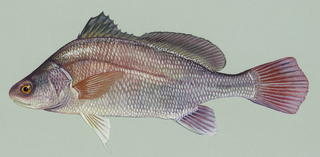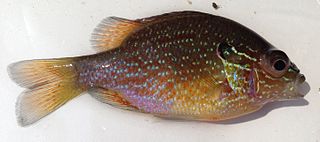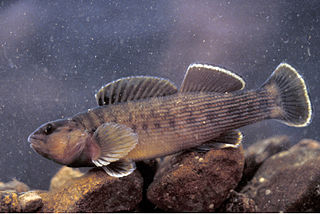
The longear sunfish is a freshwater fish in the sunfish family, Centrarchidae, of order Perciformes. It is native to the area of eastern North America stretching from the Great Lakes down to northeastern Mexico. The longear sunfish reaches a maximum recorded length of about 24 cm (9.4 in), with a maximum recorded weight of 790 g (1.74 lb). Most do not live beyond six years. The longear sunfish is quite colorful, with an olive to rusty-brown back, bright orange belly and blue-green bars on the sides of its head. A unique characteristic is their elongated operculum flap, giving an appearance of a "long ear".

The sauger is a freshwater perciform fish of the family Percidae that resembles its close relative, the walleye. The species is a member of the largest vertebrate order, the Perciformes. It is the most migratory percid species in North America. Saugers have two dorsal fins; the first is spiny and the posterior dorsal fin is soft-rayed. Their paired fins are in the thoracic position and their caudal fin is truncated, which means squared off at the corners, a characteristic of the family Percidae. Another physical characteristic of saugers is their ctenoid scales, which are common in advanced fishes. Saugers have a fusiform body structure, and as a result are well adapted predatory fishes and are capable of swimming into fast currents with minimal drag on their bodies. They may be distinguished from walleyes by the distinctly spotted dorsal fin, by the lack of a white splotch on the caudal fin, by the rough skin over their gills, and by their generally more brassy color, or darker color in some regions. The typical sauger is 300 to 400 g in weight.
The Atlantic silverside, also known as spearing in the northeastern United States, is a small species of fish from the West Atlantic, ranging from the Gulf of St. Lawrence in Canada to northeastern Florida in the USA. It is one of the most common fish in the Chesapeake Bay and in the Barnegat Bay. It is a common subject of scientific research because of its sensitivity to environmental changes.

The freshwater drum, Aplodinotus grunniens, is a fish endemic to North and Central America. It is the only species in the genus Aplodinotus, and is a member of the family Sciaenidae. It is the only North American member of the group that inhabits freshwater for its entire life. Its generic name, Aplodinotus, comes from Greek meaning "single back", and the specific epithet, grunniens, comes from a Latin word meaning "grunting". It is given to it because of the grunting noise that mature males make. This noise comes from a special set of muscles within the body cavity that vibrate against the swim bladder. The purpose of the grunting is unknown, but due to it being present in only mature males and during the spawning season, it is assumed to be linked to spawning.
Menidia is a genus of Neotropical silversides native to freshwater, brackish and marine habitats along the Atlantic and Gulf of Mexico coasts of North America, ranging from the Gulf of Saint Lawrence in Canada to the Yucatán Peninsula in Mexico. The species M. clarkhubbsi, an all-female species, reproduces asexually.

The emerald shiner is one of hundreds of small, silvery, slender fish species known as shiners. The identifying characteristic of the emerald shiner is the silvery emerald color on its sides. It can grow to 3.5 inches in length and is found across North America from Canada to the Gulf of Mexico, commonly in large, deep lakes and rivers, though sometimes in smaller bodies of water as well. It feeds on small organisms such as zooplankton and insects, congregating in large groups near the surface of the water. It is a quite common fish and is often used as a bait fish.

The brook stickleback is a small freshwater fish that is distributed across the US and Canada. It grows to a length of about 2 inches. It occupies the northern part of the eastern United States, as well as the southern half of Canada. Small populations are scattered throughout the Mississippi-Great Lakes basin extending to Colorado, New Mexico, Kentucky, Tennessee, etc., though some of these areas are not native to the species. This small fish inhabits clear, cool streams and lakes. They eat small invertebrates, algae, insect larvae, and occasionally their own eggs. They are also preyed upon by smallmouth bass and northern pike. Feeding time is usually dawn and sunset. The brook stickleback does have active competition mostly from minnows, but feeding times are different, along with diet. Spawning occurs in midsummer. Males secure a territory, build a nest, and mate with females. Males provide protection for the eggs, ward off predators, and usually die later in the season. This is considered an annual species. The nests are built out of aquatic grasses. Though the brook stickleback is not considered a threatened species, deforesting and changing waters are altering ecosystems of the species. Harvesting of trees around riparian environments is having a large effect of the stream ecosystem where the brook stickleback resides.

The trispot darter is a species of freshwater ray-finned fish, a darter from the subfamily Etheostomatinae, part of the family Percidae, which also contains the perches, ruffes and pikeperches. It is endemic to northern Georgia and southern Tennessee in the United States, where it occurs in the Conasauga River and its tributaries and historically in the Alabama River system. It requires two interconnecting habitats; outside the breeding season it occupies the peripheral zones of the main river, with slow-moving water and silt gravel substrates with vegetation cover; during the breeding season it moves to warmer water with a clay-bottomed substrate with much vegetation. The population of this fish is declining due to loss of suitable habitat because of stream impoundment and land development. The International Union for Conservation of Nature has assessed its conservation status as being "vulnerable".

The frecklebelly madtom is a species of fish in the family Ictaluridae endemic to the United States. Madtoms are in the genus Noturus, which is a group of catfish prevalent in North America.
The bigeye shiner is a species of ray-finned fish in the genus Notropis. This fish is a slender, silvery minnow with a dusky lateral stripe and a maximum total length of about 80 mm. Its distinct characteristic is its large-diameter eyes. It is a common species in upland streams of the middle Mississippi River system. Bigeye shiners prefer warm, quiet pools with clear water and silt-free substrates. Siltation, channelization, and gravel dredging are all threats to bigeye shiner populations. During spawning season, typically late April to August, bigeye shiners have several clutches of eggs. State agencies and the EPA have both played a role in the surveying of bigeye shiner populations. Populations have decreased in Ohio due mostly to habitat destruction. In addition to habitat destruction by humans, habitat alteration of the small streams and dried pools has also had a significant effect on abundance. Rivers and streams should not be channelized or modified in any way, which is becoming an increasingly popular trend in urban locations. Agricultural areas and properties within the watershed should adhere to regulations to prevent runoff into the streams.
The plains minnow is one of the 324 fish species found in central United States. It is a large minnow that was once a common bait fish. The plains minnow requires shallow, slow-moving streams to complete its life cycle. Pollution, dams, and introduced sport fish have caused populations to decline.
The scarlet shiner is a freshwater fish native to the eastern United States.
The river chub is a minnow in the family Cyprinidae. It is one of the most common fishes in North American streams.

The brindled madtom is a small catfish of the family Ictaluridae that is native to the eastern United States.
The northern madtom is a freshwater fish.

The dollar sunfish is a species of freshwater fish in the sunfish family of order Perciformes. It is categorized as a warm water pan-fish. Early settlers said that this species of sunfish resembled a European species they called bream. Historically it has been found along the Southern Atlantic coastal drainages from North Carolina to Florida, and west to Texas. Lepomis marginatus mainly feeds on detritus and filamentous algae as well as a few terrestrial insects. The juvenile and mature fish do not have many predators, but the eggs in the nest are in danger of predation from a few different species of fish.

The bluebreast darter is a small species of freshwater ray-finned fish, a darter from the subfamily Etheostomatinae, part of the family Percidae, which also contains the perches, ruffes and pikeperches. It is endemic to the eastern United States from New York and Illinois to Tennessee and North Carolina.

Etheostoma rufilineatum, the redline darter, is a species of freshwater ray-finned fish, a darter from the subfamily Etheostomatinae, part of the family Percidae, which also contains the perches, ruffes and pikeperches. It is endemic to the southeastern United States.

The snubnose darter is a species of freshwater ray-finned fish, a darter from the subfamily Etheostomatinae, part of the family Percidae, which also contains the perches, ruffes and pikeperches. It is endemic to the southeastern United States.

The gilt darter is a species of freshwater ray-finned fish, a darter from the subfamily Etheostomatinae, part of the family Percidae, which also contains the perches, ruffes and pikeperches. It can be found in a number of states in the Mississippi River drainage of the United States although it has been extirpated from some river systems in which it was at one time present, mostly due to siltation and pollution problems. Males are more colorful than females and can grow to a length of about 9 cm (3.5 in). It is a benthic fish that feeds primarily on small aquatic insect larvae. Males form territories during the breeding season in late spring and early summer. Spawning typically takes place at the upper ends of riffles with sandy and gravelly bottoms interspersed with larger cobbles. Some organisations are endeavouring to conserve populations of the gilt darter and re-introduce it to states where the fish has been extirpated but suitable habitat still exists.















